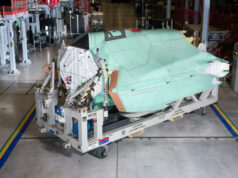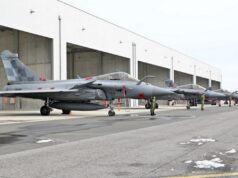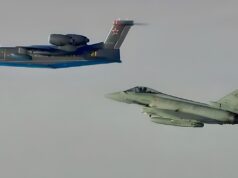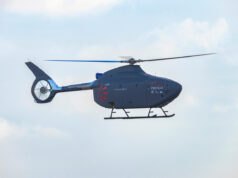The UK’s missile defence capabilities are in urgent need of improvement, according to a new report from the House of Lords’ International Relations and Defence Committee.
Published on 26th September 2024, the report, titled “Ukraine: A Wake-Up Callâ€, highlights the UK’s vulnerabilities and calls for significant investment in integrated air and missile defence (IAMD), drawing on key lessons from Russia’s invasion of Ukraine.
Lord de Mauley, chair of the Committee, did not mince his words: “Successive governments have attempted to maintain the notion of the UK as a global power, but the war in Ukraine has been a wake-up call, laying bare the gap between that ambition and reality.â€
One of the report’s central themes is the pressing need for the UK to invest in modern missile defences. The war in Ukraine has shown how crucial air superiority and missile defence are in today’s conflicts. The Committee stresses that the UK must not fall behind: “The war in Ukraine has demonstrated that air defences are essential to prevent attritional ground conflict,†the report states, urging the Government to make air and missile defence a top priority.
While the UK’s geographical position does offer some protection from direct missile strikes, the report warns against any sense of complacency: “Unlike Ukraine, the UK is comparatively protected by geographical distance from attacks by ground-based short-range missiles (and drones). However, there is no cause for complacency.â€
The report further notes that in the event of a NATO conflict with Russia, the UK could become a key target due to its strategic role as a primary base for US forces entering Europe. The Committee highlights the fact that the UK remains vulnerable to “long-range missiles, submarine-launched missiles, and standoff munitions fired by combat aircraft and stealth fighters.â€
A major concern highlighted by the Committee is the UK’s over-reliance on the United States for missile defence capabilities, a situation the report describes as “unsustainable.†The UK is heavily dependent on US assets for air defence, particularly in suppressing enemy air defences (SEAD). The Committee warns that “No European NATO air forces have sufficient expertise or munitions stocks to conduct suppression and destruction of enemy air defences (SEAD/DEAD) at scale.â€
To mitigate this, the Committee calls for greater collaboration with European allies. It highlights the European Sky Shield Initiative (ESSI), a German-led project aimed at establishing a European air defence system, which the UK has expressed interest in joining. The report encourages the Government to seriously consider joining the ESSI and “provide an assessment of the merits of joining the initiative and update us on progress.â€
The Committee points to successful European defence collaborations, such as the Aircraft Carrier Alliance, as models for how the UK could work with its partners to fill gaps in missile defence capabilities. “Working with our European NATO partners on interoperability and joint procurement to fill capability gaps makes great sense and can manage some of the high costs involved by helping to deliver economies of scale,†the report suggests.
The Committee does not shy away from criticising the UK’s previous lack of investment in missile defence, noting that while progress is being made, it remains slow: “While these developments are welcome, we note that they are still very much in their infancy and will require greater prioritisation, as well as significant time and investment to mature.â€
The report references NATO’s 2023 Vilnius summit, where the importance of improving air defences was recognised, with commitments to enhance readiness and capabilities. However, the Committee urges the Government to accelerate its own efforts, pointing out that IAMD and SEAD/DEAD capabilities come at a “significant financial cost, both in terms of equipment and training.â€
The UK has taken some initial steps, such as plans to enhance its maritime-based Sea Viper air defence system by 2028 and contribute to NATO’s Ballistic Missile Defence Radar. The report also highlights the Ministry of Defence’s DIAMOND initiative (Delivering Integrated Air and Missile Operational Networked Defences), which aims to improve interoperability with European allies.
Beyond missile defence, the report raises concerns about the broader risks to the UK’s critical national infrastructure (CNI), drawing parallels with the hybrid and conventional attacks Russia has launched against Ukraine’s CNI. The Committee calls for a “whole-of-Government effort†to strengthen the UK’s resilience against these threats, including from cyber and electromagnetic warfare.
“Russia has targeted Ukraine’s critical national infrastructure through hybrid and conventional attacks, and the UK is not exempt from these threats,†the report warns, urging the Government to take a more holistic approach to national defence.














They won’t spend the money.
Is anyone listening to all this advice? What’s happening to the Sky Sabre CAMM program in the UK? Why not some SAMP/T for the UK? Shared inventories with the RN Aster/CAMM won’t be wasted.
Simple reason, the RAF doesn’t see BMD as its job and the British Army never spends money on new capabilities because it’s leadership is very low bar.
The RAF is responsible for the Defence of UK airspace (and for space). The Army is responsible for local air defence of land assets (i.e. deployed forces). Why would the Army spend money on BMD capability?
Because the army now controls all land based air defences. Who would you think would be responsible for BMD?
“Air Defences” for me also include radar and associated c3 systems. The RAF control those, not the army.
If you meant actual missile systems, sure.
If BMD ever happened I would naturally place it with the RAF. The Army is expeditionary.
It’s the elected government’s job to provide leadership top down and it should be an integrated forces effort not one against the other or one or the other. Time to work together, don’t they train for that? In today’s climate I think GBAD should be an absolute priority something that some European countries seem to be taking more seriously than the UK. Maybe having a couple of super Aegis style ABM destroyers that Japan’s building might do the trick or a couple of Aegis ashore style sites with vls? We’ve all talked about this in previous posts.
Aegis ashore ABM is based in Romania and Poland for precisely to intercept ballistic objects from the direction of Iran or ruZZia.
No point in basing one in UK, the ABM’s would not aquire enough range for the intercep. It be better to deploy a T45 in the Baltic at highten tensions.
CAM-MR would be better bet against cruise type medium range missiles fired from off shore ships or subs.
Either way, it’d be sensible to get something more substantial a happening to protect the country, its people and precious assets including the very ports and bases the defence forces operate from.
Would CAMM launchers work as static units? So rather than being truck mounted they’re on a base mount like NASAMS or even pallet mounts?
Actually, Aegis ashore BMD would be the ideal means to defend Australia from ballistic threats. Based in the North would give plenty of time to intercept a target.
Australia is huge, the size of Europe or the USA. There’re already over the horizon radars up in the North and more radars coming. Not sure on actual ground based missiles at the moment besides NASAMS and SM3&6 on the Hobart’s, and the Hunter class and LOSVs (large optionally manned surface vessels) to come. The RAAF also has a decent sized E7 (6) and P8 (12+2 additional) fleet.
What about CAMM-MR?
Not a peep on that for ages and it seemed like such a promising programme not just for land based but also naval area defence.
CAMM-MR is in development, contracts have been signed.
Exactly, we have two OTC solutions ready to go in SAMP/T and Arrow 3 and we are part of two European consortiums to deliver them and neither the RAF or Army or the MOD has a plan to buy a single missile.
Thank god the Navy had the foresight to build its destroyers with BMD capability in mind.
Imagine if instead of pumping many billions into FRES and MRA4 we had bought 6 more T45’s. we be able to defend Cyprus, uk and Red Sea.
Jim, you realise that the only reason that the Army ‘owns all land based AD assets’ is because it invested in those to fulfil its requirements to meet its role. It’s for tactical air defence of deployed forces.
The RAF is responsible for the air defence of the U.K. – the fact that it wasn’t necessarily over the last few decades to prioritise the capability is the issue we face. And that’s because with limited funding other things were emphasised.
Also – do you actually know why FRES never came to fruition? It’s because the Army was focussed on campaign success in Afghanistan and pumped all funding into that. So it prioritised away from its core role – and now is left in the state that it is.
Your line of thinking from the other side would be ‘thank goodness the Army has maintained infantry, because the Royal Navy have chosen to draw down the RM into a token force of raiders with no real role and they’ve done away with amphibious theatre entry capability.’
Yes, the T45 is UK’s best means of defending an island from long range missiles.
Don’t think this report will make any difference plenty of true words but no will just like the conservative government. 🙄
Well no shit. Who’d have thought it?
Bring back the good old ‘Blood Hound’ at least they looked as if we were prepared.
But they defended just a handful of RAF bases, rather than the country as a whole.
The Bloodhound sites were all concentrated on the east coast and created a thick wall along the middle of the country, anything approaching the numerous RAF bases in East Anglia from the North Sea would have to have passed over multiple sites. The MK 2 had about a 100mi range against bomber aircraft, whilst they were primarily protecting the RAF bases in Lincolnshire, Norfolk, Suffolk ect the given range of the missile and the amount of launch sites also created a convenient and very dense defensive line on the main approach to London – of course protecting the south of the country and nothing else.
Now we have three main RAF bases on the UK mainland which are not even protected properly- complacent or what?
A lot of concentration of defence assets and personnel and next to no overhead protection not to mention the rest of the UK. It seems to be an incredibly stupid gapping sized hole. There’re systems available and opportunities for shared inventories. Other countries are taking it more seriously. Hopefully it’s not complacency and they can’t be that stupid. Up to the Defence Minister to allocate responsibilities for it and get it done.
But we can’t even do that now!
This one will generate a few comments!
One scenario is where the US gives Ukraine the OK to us the UK’s Storm Shadows against targets in Russia. Putin then decides to make an example of the UK and fire something conventional against a UK asset. Can the UK even defend against that?
I’m not confident that the US would then help the UK strike back, or indeed would any of the other “Allies.” Once again the UK is left as the patsy – principled, but still left holding the baby of freedom.
That would be a NATO article 5 treaty situation – an attack on a NATO country and an act of war. Russia despite its bluster knows it would badly loose a conflict with NATO so would not risk such an action.
….In theory yes… .However, if Trump gets in plus far right in Germany and France…..I’m not so sure.
I think Russia would not chance its luck. However I agree we should build up are national defences. We should buy Aster 30 1NT/block 2 backed up by CAMMs MR for local defence. We should cover key national sites both military and civilian. We should also buy extra E7s for covering over the horizon to counter cruise missiles.
You seriously think US&A would risk DC, NY, SF, LA for London getting flattened??? Article 5 is only relevant if it’s used. The spams would choose not to use it imo, then they’ll pickup the finances London is/was involved in.
Yes, and why the wait to be hit and then triggering Article 5? Why not a bit of extra protection in place so you don’t get hit? We put lots of missiles on ships so why not some more on land?
I vote for a comprehensive, layered, “Iron Dome” style system – including exo-atmosphere stuff and anti-ICBM.
To act as a deterrent, I would also go for converted airliners carrying shed loads of long-range, stand-off cruise and ballistic missiles patrolling the skies 24/7, and another set of the same patrolling UK approaches/airspace with a shed load of long-range air to air missiles to give a bug-out distance before the Typhoons can take-over.
That is exactly what I think will happen. I seriously doubt that the US&A would allow us to retaliate, even if London was turned in to glass.
“Unlike Ukraine, the UK is comparatively protected by geographical distance from attacks by ground-based short-range missiles (and drones). However, there is no cause for complacency.†Do they know there’s still airborne delivery platforms, ships, submarines, and other delivery platforms are? It makes you think they never learnt anything from the Cold War. People during WW1 thought distance was enough and the Germans proved that with Zepplins.
The article goes to say the following in the next paragraph second sentence;
‘The Committee highlights the fact that the UK remains vulnerable to “long-range missiles, submarine-launched missiles, and standoff munitions fired by combat aircraft and stealth fighters.†‘
So yeh I think they are aware and they made the point… I’m also pretty confident that the Government is aware as well, the MoD was aware decades ago when I was working for them. It’s down to choices and risks. The risks are moving in the wrong direction pretty rapidly these days, so past choices are now coming home to roost.
Can kicking has been a political game played by every Government that I can remember and I can remember quite a few now. Trouble for this Government is that the pile of cans has got too big to kick without serious injury to the foot doing the kicking. The music has stopped, to mix my metaphors, especially on defence…
Cheers CR
Spot-on!
Thanks. Trust my phone to cover up that next paragraph. Lol
Is even an incremental increase in GBAD such a big thing? Small steps to bigger steps where the budget allows. France, Italy have just ordered additional Aster SAMP/T, has the UK ever considered it? Same missiles as on the T45s. Are they looking at adapting the Asters to fire from MK41s or where is the CAMM-MR at?
And vulnerable to drones/missiles fired from standard shipping containers either in country or from commercial ships
UK was the first country to be systematically attacked from the air(Zeppelins in WW1), the first to be attacked by cruise missiles, the first to be attacked by ballistic missiles(V1, V2).
We deployed Bloodhound SAMs until 1991. Our manned fighter air defence is probably adequate against the small numbers of Russian bombers. But we have no defence against cruise or ballistic missiles. To develop one would be very expensive and perhaps less than fully effective.
Our best solution might be a combination of short range SAM defence of critical targets- military bases, power stations eg- and deterrence. Russia feels free to attack Ukraine with missiles and drones because Ukraine cannot retaliate at the same level. If they could and did, I suspect the attacks would stop. So UK should develop a long range, ground launched, conventionally armed cruise missile, capable of hitting key targets 2000+ miles away.
This combination ought to be effective and, relatively, affordable.
I would look at adapting the SEA VIPER to land application. Oh, wait France has already done it… OK the UK version uses SAMPSON radar so I’m sure we could ‘cobble’ something together pretty quickly after all the RN is already doing most of the stuff, excepting the radars may need to be updated to function effectively over land, background clutter, (hills, trees, tower blocks, mobile phones, etc…)
The advantage is that the extra radars would encourage new development and reduce costs which would benefit the RN’s T83 program. In fact, I would make UK surface based air defence a joint enterprise.
I would give the Royal Artillery responsibility for protecting deployed forces and working with allies to create a European ground based system as in this context (the defence of the UK) they would be deployed in Europe. The RAF Regiment could get its Air Defence role back and be responsible for defending key fixed installations both military and civilian and the RN would be responsible for the maritime environment, including thinning out in coming attacks launched by hostile maritime platforms. The RN is also well ahead of the other two services in deploying large advanced air defence systems…
Cheers CR
It’s not the total solution, but it should be noted that Ukrainian air force MiGs, F-16s, etc. are quite heavily used for downing cruise missiles. We should not forget that Typhoon with ASRAAM and Meteor would be very capable of doing the same- and Meteor may well have a latent BMD capability that no-one has looked into (complexities about being in the right place at the right time to launch aside). All I’m saying is we have better than ‘no’ defence.
Probably also worth bearing in mind that we have more limited avenues for Russia to be attacking from; to our North and east, and we’re surrounded by quite the layer of allies. I realise that we shouldn’t just rely on others for our defence, but we need to run a cost/risk analysis too. We’d be better spent putting capable radars and missile interceptors across the north of Scotland, than in Cornwall for example.
We should also be prioritising GBAD for our forward-deployed troops before UK-based infrastructure; Our battlegroup in Lithuania is far more likely to be hit than Portsmouth (as an example). They should be getting a mobile layered GBAD solution out to at least 60 km before we start building bunkers for missiles alongside the radar test station at Portsdown.
Indeed, interception by manned fighters is possible but difficult if large numbers of stealthy cruise missiles are launched. If the interception rate is not close to 100% ,(it won’t be) deterrence by counter attack might be a better solution. Guaranteeing,verifiably, that they don’t have nuclear warheads makes them inherently more likely to be used and therefore adds considerably to overall deterrence.
Argentina’s military weren’t deterred by Britain’s nuclear weapons because they judged, rightly, that we wouldn’t use them. The ability and willingness to hit critical targets in Argentina with long range cruise missiles almost certainly would have deterred them
We also have zero civil defence protecting critical infrastructure
As much as I’m sure we’d all love to see a system like this for the country, I can see two decent size issues with getting this done.
The first being the money to develop and procure the system, something would have to go or would need a pretty good increase in the defence budget.
The second being manning, which we all know is in a bit of a state as it is, where would the extra people come from to run these things and provide security for them?
You could employ missile systems at existing already protected bases and because they’re UK based you could partially man them with reservists. You could expand existing programmes such as Sky Sabre and not need to waste resources developing new solutions. This isn’t even as difficult as introducing a new aircraft type into the RAF.
The origins of this deficiency go back to the Cold War era, where we relied on European nations and USA to provide long-range missile cover for our forces in Germany and the RAF’s preference to focus on fighter v fighter optimised air defence, regardless of the growth in missile and drone threats.
Better off creating a proper deterrent. Realistically it’s only Russian subs we should be concerned about for now. Up the T26 numbers to 12 and 5 for Norway and create a shoot and your dead scenario as opposed to a shoot and scoot that might be possible with present numbers. Plus they have the added potential of dragonfire and LDEW when they come online if Russia does create some new threat.
The committee could not have made it any clearer but will anyone take heed in the sleepy halls of Whitehall? The whole of the armed forces at a parlous state. So depressing as nothing ever changes. Gulf War 1 seems almost like the golden age in comparison to what can be mustered today.
Hard to believe how much has gone 😟
Having spent two hours typing in my response to the government defence review, only to see it timed out, I now managed to submit a much reduced contribution that still highlighted an urgent need for even a basic SAM/GBAD system for the UK mainland. Will Rachel Reeves listen?
Don’t think she knows what GBAD means John
Why not purchased THAAD batteries and or ground based interceptor missiles from the Americans as we get most of tech from them anyway so why should our BMD capability be any different
£££££££££££££££
THAAD batteries are for, if you had a hostile next door neighbour with ballistic missiles aimed at you.
Not the case with the UK! The hostile neighbour is much further away, so a different trajectory would be used to target the UK.
.
At last ,wake up and smell the coffee ☕ï¸,
In a Nato Russian conflict there will not be any time for defense mechanism as military leaders think, it will not be a conventional war. In the beginning itself all satellite systems will be destroyed and Europe will be nuked which Poland, England and France will be primary targets., for it there is no need of hundreds of missiles as these countries are small small enough to take down by strategic nuclear weapons. Only countries with bigger land mass like US and Russia can survive, but if hundreds of missiles with nuclear tips fly then it will total destruction and end of life in earth, The Europeans don’t consider these things when they go for Nato expansion to create anarchy in this small world.
Most of your wonder warpons fail to meet expectations, in each test, Ivan!
Most of your ICBM’s will have a lot parts missing! Western Intel will know when you plan to launch some that might work, and act accordingly with a plan!
So still working hard for your masters in the Kremlin!
There won’t be a NATO/Russia conflict. NATO has no interest in Russian land. Therefore it’s not under existential threat. Not from NATO anyway. China on the other hand has a lot of eyes on what it sees as historical Chinese lands. An area 50 times the size of Taiwan in Russian territory. China has already redrawn a map claiming disputed territory, shall we say, as its own. Ironic really that Putin is helping fund Chinas potential invasion of Russia by selling it cheap oil and gas.
Lord.de Mauley, obviously inbred to fcuk.
Don’t like him personally or just hate anyone with a posh title?
Oh don’t worry, I am sure the Spanish will supply and repair any ships we need, even if the Argies decide they want the oil in the Falklands or we need to defend Gibraltar… Just ask the UK government who aren’t prepared to guarantee paying Harland and Wolff thus killing a shipyard and putting 500 out of work because they are getting a better kick back from Spain
For effective Defence you have to spend what it costs. Example if you are quoted £100 for a job. Don’t spend £75, you haven’t saved £25 you’ve wasted £75 as it won’t achieve what you want. If we want to be a ‘first rate’ military power we need to spend accordingly. The alternative is to perhaps acknowledge that we aren’t and we cannot do everything.
Just like all politicians in the past they have too short sighted when it comes to defence.
This government needs to really wake up and start putting money into defence now, not over a 7 year period. That’s a little too late. Perhaps their salary’s, spending & gifts ought to be taxed more or donated into defence spending. (Miow!!)
Get the folk that aren’t working, working on defence projects such as building aircraft, weapons, bunkers. Educate kids on more industrial projects that the uk is in need of, from cyber to basic nursing skills etc.. The women did it for the last war effort. We all need to come together as a nation and support each other. Who am i to say? I’m Just a mere uk citizen that is actually feeling really concerned right now and worry for the future of our children.
The UK is FFBNW BMD, SHORAD, DEW, etc